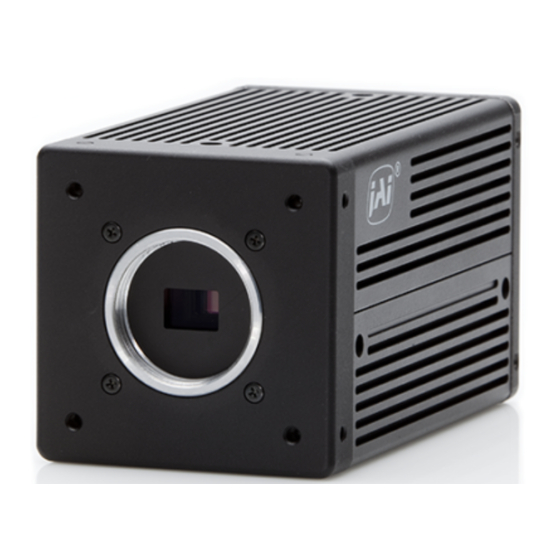
Advertisement
Table of Contents
- 1 Using a 2CCD Camera to Create High-Dynamic Range Images
- 2 Calibrating Sensor Response and Output
- 3 Example 1 - Maximum Dynamic Range (no Overlap)
- 4 Displaying a High Dynamic Range Image on a Standard Monitor
- 5 Example 2 - Overlapping Dynamic Range
- 6 Example 3 - Averaging the Overlap
- 7 Example 4 - Dual-Slope Dynamic Range
- Download this manual
Tech Note
TN-0902
Date: 02/06/09
UsiNg a 2CCD Camera To CreaTe HigH-DyNamiC raNge images
Some imaging scenarios push dynamic range beyond the capabilities of the typical sensor. This is especially
true where incident light is present (e.g., imaging a light source and the surrounding area). This can also
occur in situations with bright reflections or in high contrast indoor/outdoor scenes where one needs to cap-
ture details in both bright sunlight and dark shadows. One technique for dealing with these situations is to
combine or "fuse" two images with different exposures so that the dynamic range is significantly increased.
An illustration of this technique can be seen in the following images captured by JAI's AD-081 camera. Here,
the incident light coming from the light bulb makes it impossible to examine both the bright and the dark
areas of this scene in a single exposure. Instead, two exposures are used as shown in Figure 1. The left half
of the image shows what the image looks like when captured with a slow shutter speed. This is able to
capture details in the surrounding areas while letting the brightest parts of the scene over saturate. The
right half of the image shows the result of a much faster shutter speed, enabling details to be seen in the
brightest portions of the image while rendering much of the surrounding area as nearly black. When "fused,"
as shown in Figure 2, the composite image is able to span the full dynamic range of the scene.
FIGURE 1 – Bracketing the exposure
FIGURE 2 – Fused HDR image
In landscape or architectural photography, this effect be achieved with a single CCD camera taking two
consecutive images. However, in "live action" settings – such as industrial inspections, surveillance, vehicle
applications, and the like – the presence of motion requires simultaneous capture of the two images that are
to be fused. This can be done with two cameras, looking at the same scene. However, to avoid alignment is-
sues, it is best if the CCDs are in a single camera with a prism-based 2CCD arrangement. The AD-081 camera
from JAI uses this 2CCD prism-based approach to increase dynamic range while ensuring precise registration
of the two image streams.
Note: in some industrial settings, it may be possible to use a one-camera scenario if the object being in-
spected stops briefly and the camera being used has the ability to automatically take two closely-spaced im-
ages with dramatically different gain and/or shutter settings. JAI's "sequence trigger" function supports this
approach, where feasible. It is available in many of the company's C3 Camera Suite models with GigE Vision
interfaces.
Calibrating sensor response and output
In a 2CCD scenario such as the AD-081CL, establishing a high dynamic range image comes from fusing the
output of the two sensors to effectively increase the bit depth of the final image. The mathematical equa-
tion for the display then becomes a function of the calibration of the 2 sensors. There are several strategies
that can be used.
Advertisement
Table of Contents

Summary of Contents for JAI AD-081
- Page 1 This can be done with two cameras, looking at the same scene. However, to avoid alignment is- sues, it is best if the CCDs are in a single camera with a prism-based 2CCD arrangement. The AD-081 camera from JAI uses this 2CCD prism-based approach to increase dynamic range while ensuring precise registration of the two image streams.
- Page 2 Tech Note Example 1 - Maximum Dynamic Range (no overlap) To create an image that spans the maximum range of light intensities, use shutter settings to calibrate the 2 sensors so that Sensor B = Sensor A * 1024. In other words, the light needed to generate 100 counts from Sen- sor B is 1024 times the light needed to create 100 counts from Sensor A.
- Page 3 Tech Note Displaying a high dynamic range image on a standard monitor will require mapping the output to fit the monitor’s dynamic range capability. For the image described above, start by creating a 20-bit image map using the raw pixel data. Then create a 10-bit image map to display on the monitor by dividing the 20-bit im- age map by 1024.
- Page 4 Both of the preceding examples assume that a precise calibration can be made between the two sensors, resulting in a linear output (when plotted on a logarithmic scale). In reality, even the AD-081’s programmable exposure capability, which allows shutter speed to be adjusted in one-line increments (42.07 µs), will still not provide the precision needed for perfect calibration.
- Page 5 Tech Note Now as Sensor A approaches its saturation point (512 – 1023 counts) the output uses the average of both sen- sors’ data to “smooth” the transition between the two sensor response graphs (see Figure 6). It still limits the use of the lowest bits on Sensor B (those that are most susceptible to noise) and keeps the calibration factor at 64 to increase the output precision of the upper bits.
- Page 6 Be aware, however, that increasing gain will also impact the noise level of the sensor output, which may or may not be acceptable for a particular application. For more information about high dynamic range imaging or the AD-081 camera, please contact JAI. No. TN-0902 pg 6...















Need help?
Do you have a question about the AD-081 and is the answer not in the manual?
Questions and answers